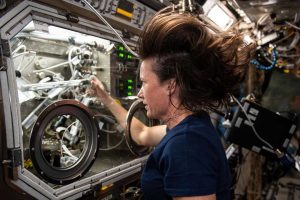The US Space Agency highlights the work of its three competing commercial space station partners – Axiom Space, Orbital Reef and Starlab – for the design and development of possible new “orbital destinations”.
“We are ending the year on a high note with multiple important milestones being completed by our partners,” said Angela Hart, manager of the Commercial Low Earth Orbit Development Program at NASA Johnson Space Center. “Over the past few months, we have been able to dig into the details of the specific hardware and processes of these stations and are moving forward to multiple comprehensive design reviews next year.”
Axiom Hab One module
For example, Axiom Space, which holds a firm-fixed price, indefinite-delivery, indefinite-quantity contract with NASA, is on schedule to launch and attach its first module, says the agency. The module is named Axiom Hab One, and is due to attach to the International Space Station in 2026.
Four modules are planned for the Axiom Commercial Segment attached to the station. And after the space station’s retirement, the Axiom Commercial Segment will separate and become a free-flying commercial destination, named Axiom Station.
“The hatches of the Axiom Hab One module are fabricated and prepared to undergo pressure testing to ensure a strong enough seal to withstand the vacuum of space,” writes Nasa. “Manufacturing of the Axiom Hab One module is underway, and the critical design review will occur in 2024. During this review, NASA will assess the maturity of the Axiom Space design and provide feedback necessary to ensure safe operations when it is attached to the International Space Station.”
Blue Origin Orbital Reef
The Jeff Bezos-backed Blue Origin, which was awarded a contract by Nasa in 2021 to develop a free-flying space station named Orbital Reef, has also recently completed tests, reports the agency – for a window system and a structural demonstration. It writes:
“For the structural test, Blue Origin used a prototype of their space station’s main module, called the Core, to demonstrate the manufacturing processes required to build the final pressurized modules of the station. The test supports validation of the structural models and analytical tools for the Core’s structural design.”
“The International Space Station’s cupola, a room with seven windows overlooking the Earth, is the cornerstone of crewed missions for both research and astronaut morale. Orbital Reef will incorporate multiple windows on its Core, with each window spanning about twice the size of a car windshield. For the window test, Blue Origin evaluated the window integration structure design concept and its performance against the pressures and temperatures the windows will be exposed to while in orbit.”
Starlab optical link
The third example given of progress for a new space station involved Starlab, a station being developed by Voyager Space’s Exploration Segment, in partnership with Airbus and Northrop Grumman.
Voyager Space recently completed three milestones, said the North American agency: a system definition review and the initiation of two pairs of milestones for an optical link demonstration and alternative urine processor demonstration.
“Free-space optical, also called laser communications, allows for higher data rates and more energy-efficient communications than radio frequency communication systems. A major goal of the optical communication demonstration is to conduct testing from the International Space Station to the ground to establish the capabilities needed for Starlab. This initial milestone, within the optical link demonstration milestone pair scope, validated the Starlab testing plan. The optical link is planning to be tested next on the International Space Station.”
You can read more on the Nasa website.
The ISS is expected to be “deorbited” by a dedicated NASA spacecraft in 2031.
Image: Axiom Space – A hatch of the Axiom Hab One module, which will attach the module to the ISS.
See also: Nasa invites students to rise to 2024 Human Exploration Rover Challenge
 Electronics Weekly Electronics Design & Components Tech News
Electronics Weekly Electronics Design & Components Tech News





Exciting progress in new space station development by NASA and partners Axiom, Blue Origin, and Voyager Space. Milestones like Axiom’s Hab One module and Blue Origin’s window system tests showcase innovation in space exploration. Promising outlook for the future.